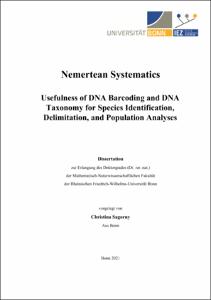Nemertean SystematicsUsefulness of DNA Barcoding and DNA Taxonomy for Species Identification, Delimitation, and Population Analyses

Nemertean Systematics
Usefulness of DNA Barcoding and DNA Taxonomy for Species Identification, Delimitation, and Population Analyses

| dc.contributor.advisor | Bartolomaeus, Thomas | |
| dc.contributor.author | Sagorny, Christina | |
| dc.date.accessioned | 2022-04-21T11:56:17Z | |
| dc.date.available | 2023-04-30T22:00:23Z | |
| dc.date.issued | 21.04.2022 | |
| dc.identifier.uri | https://hdl.handle.net/20.500.11811/9754 | |
| dc.description.abstract | The assessment of phylogenetic relationships and systematics of all metazoan taxa heavily relies on the accurate identification and delimitation of species. For the past two centuries, both species identification and delimitation have mainly been based on morphological data, in many cases accessed through histological sectioning. Although this approach allows comparing various internal characteristics, the definition of these distinctive characteristics can be challenging depending on the investigated taxa and in many cases remains subjective. Moreover, intraspecific variation can complicate the interpretation of morphological data. Therefore, taxonomy has shifted towards the application of molecular data in order to unravel species identities and the relationships within a taxon. In contrast to morphological data, molecular data can rapidly be extracted and often analyzed without expert knowledge. Moreover, molecular sequence data can be used to address numerous different problems with regard to systematics and taxonomy. Molecular-based taxonomy has been suggested at the beginning of this millennium to facilitate both species identification and delimitation. Based on DNA taxonomy, incorporating single gene sequences such as the mitochondrial cytochrome oxidase c subunit I (COI), systematics of problematic taxa can be unraveled. One of these problematic and understudied groups is the taxon Nemertea. Due to the lack of a widely applied standard in morphological species descriptions and the presence of only few diagnostic characters, nemertean systematics are still not fully resolved. The application of single gene sequences has helped to answer several taxonomic questions in the past 20 years, but because of the deficiency of taxonomic coverage in online repositories numerous questions remain to be answered. In several other taxa, taxonomy has shifted towards the application of next-generation sequencing approaches as an increasing number of genes allow for more accurate analyses. Nevertheless, most recent investigations on nemertean taxonomy still focus on single gene sequence approaches. This thesis presents three studies that employ single gene sequences to help resolve the muddled taxonomy of Nemertea. All examples aim at highlighting the adequacy and prevailing relevance of single gene data to answer various questions in an understudied taxon such as nemerteans. The data presented in Chapter 1 aimed at delimiting species of a problematic genus with the help of COI data, whereas in Chapter 3 single gene data is used to describe several new species based on a turbotaxonomic or an integrative approach. In contrast to this, haplotype distribution and population genetics in a cosmopolitan nemertean species is investigated in Chapter 2. Included unpublished results further underline the usefulness of COI sequence data with regard to identification of unknown specimens, detection of cryptic species, delimitation of externally similar specimens, and haplotype distribution along geographically distant populations. All cases demonstrate the lasting timeliness and usefulness of single sequence gene data. When it comes to the identification and delimitation of nemertean species, molecular single gene approaches are crucial for easily and fast acquired results as both can be achieved by comparing the sequence data. Nevertheless, a lasting problem in this regard is the lacking coverage in online repositories as nemerteans are in many cases understudied. Therefore, it is of utmost importance to increase representation of nemerteans in databases to further add knowledge and facilitate future species identification. When it comes to species descriptions, molecular sequence data alone is in many cases still not sufficient. Therefore, a turbotaxonomic approach as has already been suggested for nemerteans appears to be the best choice. In general, all future species descriptions should at least incorporate a genetic barcode and a description of external morphology, but an integrative approach combining all available data is favorable if circumstances allow it. | en |
| dc.language.iso | eng | |
| dc.rights | In Copyright | |
| dc.rights.uri | http://rightsstatements.org/vocab/InC/1.0/ | |
| dc.subject | Nemertea | |
| dc.subject | Taxonomie | |
| dc.subject | Phylogenie | |
| dc.subject | Kryptische Arten | |
| dc.subject | Artbeschreibung | |
| dc.subject | Artabgrenzung | |
| dc.subject | Taxonomy | |
| dc.subject | Phylogeny | |
| dc.subject | Cryptic species | |
| dc.subject | Species description | |
| dc.subject.ddc | 500 Naturwissenschaften | |
| dc.subject.ddc | 570 Biowissenschaften, Biologie | |
| dc.subject.ddc | 590 Tiere (Zoologie) | |
| dc.title | Nemertean Systematics | |
| dc.title.alternative | Usefulness of DNA Barcoding and DNA Taxonomy for Species Identification, Delimitation, and Population Analyses | |
| dc.type | Dissertation oder Habilitation | |
| dc.publisher.name | Universitäts- und Landesbibliothek Bonn | |
| dc.publisher.location | Bonn | |
| dc.rights.accessRights | openAccess | |
| dc.identifier.urn | https://nbn-resolving.org/urn:nbn:de:hbz:5-66305 | |
| dc.relation.doi | https://doi.org/10.1111/jzs.12266 | |
| ulbbn.pubtype | Erstveröffentlichung | |
| ulbbnediss.affiliation.name | Rheinische Friedrich-Wilhelms-Universität Bonn | |
| ulbbnediss.affiliation.location | Bonn | |
| ulbbnediss.thesis.level | Dissertation | |
| ulbbnediss.dissID | 6630 | |
| ulbbnediss.date.accepted | 04.03.2022 | |
| ulbbnediss.institute | Mathematisch-Naturwissenschaftliche Fakultät : Fachgruppe Biologie / Institut für Evolutionsbiologie und Zooökologie | |
| ulbbnediss.fakultaet | Mathematisch-Naturwissenschaftliche Fakultät | |
| dc.contributor.coReferee | Podsiadlowski, Lars | |
| ulbbnediss.date.embargoEndDate | 30.04.2023 | |
| ulbbnediss.contributor.gnd | 127046213X |
Files in this item
This item appears in the following Collection(s)
-
E-Dissertationen (4373)




